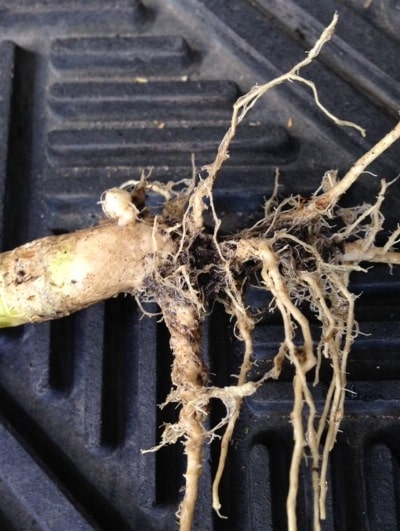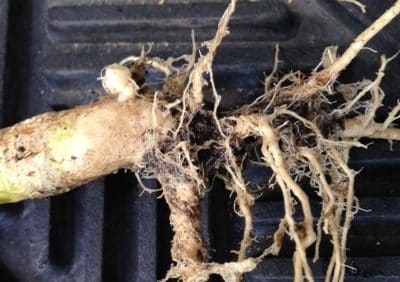
Manitoba has had two canola fields confirmed this month to have clubroot symptoms on plants. Last year, clubroot was confirmed in two soil samples in the province, but plant symptoms were not observed.
Clubroot is expected to spread across the Prairies eventually. The disease was first detected in Manitoba in vegetable crops in 1925. It is not a surprise to find it in canola fields. The key is to become more aware of the disease, what it looks like, how to scout for it, and how to prevent its spread. With early detection, use of resistant varieties and equipment sanitation practices to keep it from moving around, growers can manage the disease.
MAFRI encourages Manitoba canola growers to assume they have clubroot within 50 km of their farm, and act accordingly to prevent the spread of the disease. Clubroot spreads primarily by soil movement on machinery. It is a soil-borne disease, not a canola residue-borne disease, so be mindful of soil movement in all fields, not just those seeded to canola.
Here is what works to prevent and manage clubroot:
—Proper equipment cleaning, specifically to reduce the movement of soil on field equipment.
—If you have fields confirmed to contain clubroot, don’t use tillage on those fields. Treat them last to prevent any movement of soil to other fields on the farm.
—Clubroot-resistant canola varieties.
—Crop rotation. Note that tight canola rotation does not cause clubroot. Tight rotation can increase the rate of spore build up, but it does not cause clubroot to show up in a field.
—Good weed management of alternate hosts.
—Early seeding date
—Scouting to achieve early identification
—Zero till
—Clean inputs
—Planning. Clubroot is not just a canola problem. It moves with soil from any crop
—Quarantining infested patches. Grass them in. Change field approaches if they are infested.
Here is what doesn’t work to prevent and management clubroot:
—Tillage
—Crop rotation
—Bait crops
—Any soil amendment
—Seed treatments
—Fungicide.
—High soil pH. Studies have shown clubroot severity to be somewhat lower in higher pH soils, but high pH soil will not stop clubroot from arriving on a field and killing the canola crop.
Clubroot identification: Since the two fields were confirmed in Manitoba, growers have been coming forward with many samples that could be clubroot. In all other cases, except these two so far, the galls have been hybridization nodules. Hybridization nodules stay hard and white into the fall, while clubroot galls will have started to break down — unless it’s a very late stand of canola that’s still green. Lab tests can confirm.
It is important to remember that the spore load is probably fairly low in Manitoba at this point, so even if you have some clubroot in your field, the symptoms may not be all that obvious above ground. In other words, even without any obvious symptoms, clubroot could still be there.
Labs can also test soil samples for clubroot DNA. Clubroot most often enters a field at the entry point for machinery. Take topsoil samples from an area about 100 feet from where you start working. In that 100 feet, most of the soil that was on shovels and openers will have shaken loose. That is where clubroot is likely to start. Spores will be in the top 1” of soil. Gather soil from 5 to 10 locations within that small area, and send in a composite for testing.
Another way to test is to dig a bunch of canola plants in that area and look for galls. By now, clubroot galls will be brown and rotten, but if you dig them up carefully, you may see the shape of a gall. In that case, send in plant samples for confirmation.
Visit www.clubroot.ca for many more management tips.

